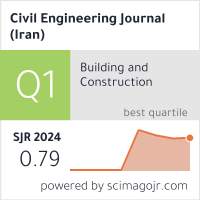Efficient Multi-Composite Cement Made of Granulated Blast Furnace Slag (GBFS) and Flash-calcined Sediment
Downloads
Doi:10.28991/CEJ-2023-09-11-02
Full Text:PDF
Downloads
[2] Matschei, T., Lothenbach, B., & Glasser, F. P. (2007). The role of calcium carbonate in cement hydration. Cement and Concrete Research, 37(4), 551–558. doi:10.1016/j.cemconres.2006.10.013.
[3] Bentz, D. P., Ferraris, C. F., Jones, S. Z., Lootens, D., & Zunino, F. (2017). Limestone and silica powder replacements for cement: Early-age performance. Cement and Concrete Composites, 78, 43–56. doi:10.1016/j.cemconcomp.2017.01.001.
[4] Bentz, D. P., Jones, S. Z., & Lootens, D. (2016). Minimizing Paste Content in Concrete Using Limestone Powders - Demonstration Mixtures. National Institute of Standards and Technology. doi:10.6028/nist.tn.1906.
[5] De Weerdt, K., Haha, M. Ben, Le Saout, G., Kjellsen, K. O., Justnes, H., & Lothenbach, B. (2011). Hydration mechanisms of ternary Portland cements containing limestone powder and fly ash. Cement and Concrete Research, 41(3), 279–291. doi:10.1016/j.cemconres.2010.11.014.
[6] Proske, T., Rezvani, M., Palm, S., Müller, C., & Graubner, C. A. (2018). Concretes made of efficient multi-composite cements with slag and limestone. Cement and Concrete Composites, 89, 107–119. doi:10.1016/j.cemconcomp.2018.02.012.
[7] Zajac, M., Skocek, J., Adu-Amankwah, S., Black, L., & Ben Haha, M. (2018). Impact of microstructure on the performance of composite cements: Why higher total porosity can result in higher strength. Cement and Concrete Composites, 90, 178–192. doi:10.1016/j.cemconcomp.2018.03.023.
[8] Joshi, R. C., & Lohita, R. P. (1997). Fly ash in concrete: production, properties and uses (Vol. 2). CRC Press, Boca Raton, United States.
[9] Boddy, A. M., Hooton, R. D., & Thomas, M. D. A. (2003). The effect of the silica content of silica fume on its ability to control alkali-silica reaction. Cement and Concrete Research, 33(8), 1263–1268. doi:10.1016/S0008-8846(03)00058-9.
[10] Teklay, A., Yin, C., Rosendahl, L., & Kí¸hler, L. L. (2015). Experimental and modeling study of flash calcination of kaolinite rich clay particles in a gas suspension calciner. Applied Clay Science, 103, 10–19. doi:10.1016/j.clay.2014.11.003.
[11] Yu, C., Sun, W., & Scrivener, K. (2015). Degradation mechanism of slag blended mortars immersed in sodium sulfate solution. Cement and Concrete Research, 72, 37–47. doi:10.1016/j.cemconres.2015.02.015.
[12] Berthomier, M., Lors, C., Damidot, D., De Larrard, T., Guérandel, C., & Bertron, A. (2021). Leaching of CEM III paste by demineralised or mineralised water at pH 7 in relation with aluminium release in drinking water network. Cement and Concrete Research, 143. doi:10.1016/j.cemconres.2021.106399.
[13] Cyr, M., Lawrence, P., & Ringot, E. (2005). Mineral admixtures in mortars: Quantification of the physical effects of inert materials on short-term hydration. Cement and Concrete Research, 35(4), 719–730. doi:10.1016/j.cemconres.2004.05.030.
[14] Moranville-Regourd, M., & Kamali-Bernard, S. (2019). Cements Made From Blastfurnace Slag. Lea's Chemistry of Cement and Concrete, 469–507, Butterworth-Heinemann, Oxford, United Kingdom. doi:10.1016/b978-0-08-100773-0.00010-1.
[15] Yüksel, I., Siddique, R., Khatib, J.M. (2008). Effect of GGBFS and GSS on the properties of mortar. In Proceedings of the Excellence in Concrete Construction through Innovation, 9–10 September 2008, Kingston University, London, United Kingdom.
[16] Richardson, I. G., Wilding, C. R., & Dickson, M. J. (1989). The hydration of blastfurnace slag cements. Advances in Cement Research, 2(8), 147–157. doi:10.1680/adcr.1989.2.8.147.
[17] Sowoidnich, T., Damidot, D., Ludwig, H.-M., Germroth, J., Rosenberg, R., & Cölfen, H. (2023). The nucleation of C–S–H via prenucleation clusters. The Journal of Chemical Physics, 158, 114309. doi:10.1063/5.0141255.
[18] Richardson, J. M., Biernacki, J. J., Stutzman, P. E., & Bentz, D. P. (2002). Stoichiometry of slag hydration with calcium hydroxide. Journal of the American Ceramic Society, 85(4), 947–953. doi:10.1111/j.1151-2916.2002.tb00197.x.
[19] Daube, J., & Bakker, R. (1986). Portland blast-furnace slag cement: a review. Blended Cements. ASTM International, Pennsylvania, United States. doi:10.1520/STP36388S.
[20] NF EN 197-1. (2000). Cement - Part 1: composition, specifications and conformity criteria for common cements. Association Française de Normalisation (AFNOR), Saint-Denis Cedex, France. (In French).
[21] Scrivener, K. L., John, V. M., & Gartner, E. M. (2018). Eco-efficient cements: Potential economically viable solutions for a low-CO2 cement-based materials industry. Cement and Concrete Research, 114, 2–26. doi:10.1016/j.cemconres.2018.03.015.
[22] Van Bunderen, C., Benboudjema, F., Snellings, R., Vandewalle, L., & Cizer, Ö. (2021). Experimental analysis and modelling of mechanical properties and shrinkage of concrete recycling flash calcined dredging sediments. Cement and Concrete Composites, 115. doi:10.1016/j.cemconcomp.2020.103787.
[23] Faure, A., Coudray, C., Anger, B., Moulin, I., Colina, H., Izoret, L., Théry, F., & Smith, A. (2019). Beneficial reuse of dam fine sediments as clinker raw material. Construction and Building Materials, 218, 365–384. doi:10.1016/j.conbuildmat.2019.05.047.
[24] Chu, D. C., Amar, M., Kleib, J., Benzerzour, M., Betrancourt, D., Abriak, N. E., & Nadah, J. (2022). The Pozzolanic Activity of Sediments Treated by the Flash Calcination Method. Waste and Biomass Valorization, 13(12), 4963–4982. doi:10.1007/s12649-022-01789-8.
[25] Banfill, P. F. G., & Saunders, D. C. (1986). The relationship between the sorption of organic compounds on cement and the retardation of hydration. Cement and Concrete Research, 16(3), 399–410. doi:10.1016/0008-8846(86)90116-X.
[26] Venda Oliveira, P. J. da, Vieira, A. F. V., & Correia, A. A. S. (2017). Effect of organic matter in soft soils on the effectiveness of preloading for foundations. Proceedings of the Institution of Civil Engineers - Geotechnical Engineering, 170(4), 305–311. doi:10.1680/jgeen.16.00082.
[27] Yang, Y., Wu, S., & Huang, X. (2021). Experimental Study on the Effect of Fulvic Acid in Waste Slurry on Flocculation and Zeta Potential. Sustainability, 13(14), 7784. doi:10.3390/su13147784.
[28] Snellings, R., Horckmans, L., Van Bunderen, C., Vandewalle, L., & Cizer, Ö. (2017). Flash-calcined dredging sediment blended cements: effect on cement hydration and properties. Materials and Structures/Materiaux et Constructions, 50(6). doi:10.1617/s11527-017-1108-5.
[29] Tironi, A., Trezza, M. A., Scian, A. N., & Irassar, E. F. (2012). Kaolinitic calcined clays: Factors affecting its performance as pozzolans. Construction and Building Materials, 28(1), 276–281. doi:10.1016/j.conbuildmat.2011.08.064.
[30] Fernandez, R., Martirena, F., & Scrivener, K. L. (2011). The origin of the pozzolanic activity of calcined clay minerals: A comparison between kaolinite, illite and montmorillonite. Cement and Concrete Research, 41(1), 113–122. doi:10.1016/j.cemconres.2010.09.013.
[31] Safhi, A. el M., Benzerzour, M., Rivard, P., Abriak, N. E., & Ennahal, I. (2019). Development of self-compacting mortars based on treated marine sediments. Journal of Building Engineering, 22, 252–261. doi:10.1016/j.jobe.2018.12.024.
[32] Benzerzour, M., Amar, M., & Abriak, N.-E. (2017). New experimental approach of the reuse of dredged sediments in a cement matrix by physical and heat treatment. Construction and Building Materials, 140, 432–444. doi:10.1016/j.conbuildmat.2017.02.142.
[33] Safhi, A. el M., Rivard, P., Yahia, A., Benzerzour, M., & Khayat, K. H. (2020). Valorization of dredged sediments in self-consolidating concrete: Fresh, hardened, and microstructural properties. Journal of Cleaner Production, 263. doi:10.1016/j.jclepro.2020.121472.
[34] Amar, M., Benzerzour, M., Safhi, A. E. M., & Abriak, N. E. (2018). Durability of a cementitious matrix based on treated sediments. Case Studies in Construction Materials, 8, 258–276. doi:10.1016/j.cscm.2018.01.007.
[35] Amar, M., Benzerzour, M., Abriak, N. E., & Mamindy-Pajany, Y. (2017). Study of the pozzolanic activity of a dredged sediment from Dunkirk harbour. Powder Technology, 320, 748–764. doi:10.1016/j.powtec.2017.07.055.
[36] Bucher, R., Cyr, M., & Escadeillas, G. (2021). Performance-based evaluation of flash-metakaolin as cement replacement in marine structures–Case of chloride migration and corrosion. Construction and Building Materials, 267. doi:10.1016/j.conbuildmat.2020.120926.
[37] San Nicolas, R., Cyr, M., & Escadeillas, G. (2013). Characteristics and applications of flash metakaolins. Applied Clay Science, 83–84, 253–262. doi:10.1016/j.clay.2013.08.036.
[38] Chen, C., Habert, G., Bouzidi, Y., Jullien, A., & Ventura, A. (2010). LCA allocation procedure used as an incitative method for waste recycling: An application to mineral additions in concrete. Resources, Conservation and Recycling, 54(12), 1231–1240. doi:10.1016/j.resconrec.2010.04.001.
[39] Zeraoui, A., Maherzi, W., Benzerzour, M., Abriak, N. E., & Aouad, G. (2023). Development of Flash-Calcined Sediment and Blast Furnace Slag Ternary Binders. Buildings, 13(2), 333. doi:10.3390/buildings13020333.
[40] Alloul, A., Amar, M., Benzerzour, M., & Abriak, N. E. (2023). Developing mortar using limestone flash-calcined dredged sediment/millstone-clay cement binder (LFC). Journal of Building Engineering, 76. doi:10.1016/j.jobe.2023.107346.
[41] Chu, D. C., Kleib, J., Amar, M., Benzerzour, M., & Abriak, N. E. (2022). Recycling of dredged sediment as a raw material for the manufacture of Portland cement – Numerical modeling of the hydration of synthesized cement using the CEMHYD3D code. Journal of Building Engineering, 48. doi:10.1016/j.jobe.2021.103871.
[42] Chu, D. C., Kleib, J., Amar, M., Benzerzour, M., & Abriak, N. E. (2021). Determination of the degree of hydration of Portland cement using three different approaches: Scanning electron microscopy (SEM-BSE) and Thermogravimetric analysis (TGA). Case Studies in Construction Materials, 15. doi:10.1016/j.cscm.2021.e00754.
[43] Schläpfer, P., & Bukowski, R. (1933). Studies on the determination of free lime and calcium hydroxide in cement clinkers, cements, and slags and set hydraulic mortars, Federal Materials Testing Institute at the E.T.H., 63, Zurich, German.
[44] NF-EN 196-3. (2017). Methods of testing cement. Part 3: Determination of setting times and soundness. Association Française de Normalisation (AFNOR), Saint-Denis Cedex, France. (In French).
[45] Chikouche, M. A., Ghorbel, E., & Bibi, M. (2016). The possibility of using dredging sludge in manufacturing cements: Optimization of heat treatment cycle and ratio replacement. Construction and Building Materials, 106, 330-341. doi:10.1016/j.conbuildmat.2015.12.128.
[46] Beaudoin, J., & Odler, I. (2019). Hydration, Setting and Hardening of Portland Cement. Lea's Chemistry of Cement and Concrete, 157–250, Butterworth-Heinemann, Oxford, United Kingdom. doi:10.1016/b978-0-08-100773-0.00005-8.
[47] Zhang, J., & Scherer, G. W. (2011). Comparison of methods for arresting hydration of cement. Cement and Concrete Research, 41(10), 1024–1036. doi:10.1016/j.cemconres.2011.06.003.
[48] Scrivener, K., Snellings, R., & Lothenbach, B. (Eds.). (2018). A Practical Guide to Microstructural Analysis of Cementitious Materials. CRC Press, Boca Raton, United States. doi:10.1201/b19074.
[49] Georget, F., Wilson, W., & Scrivener, K. L. (2021). EDXIA: Microstructure characterisation from quantified SEM-EDS hypermaps. Cement and Concrete Research, 141. doi:10.1016/j.cemconres.2020.106327.
[50] NF EN 196-1. (2016). Methods of testing cement - Part 1: determination of strength. Association Française de Normalisation (AFNOR), Saint-Denis Cedex, France. (In French).
[51] Rao, G. A. (2001). Generalization of Abrams' law for cement mortars. Cement and Concrete Research, 31(3), 495–502. doi:10.1016/S0008-8846(00)00473-7.
[52] Lecomte, A., De Larrard, F., & Mechling, J. M. (2001). Compressive strength of hydraulic concretes to the unoptimised granular skeleton. Bulletin LPC, 234, 89-105. (In French).
[53] Amar, M., Benzerzour, M., & Abriak, N. E. (2018). Towards the establishment of formulation laws for sediment-based mortars. Journal of Building Engineering, 16, 106–117. doi:10.1016/j.jobe.2017.12.011.
[54] Lothenbach, B., Scrivener, K., & Hooton, R. D. (2011). Supplementary cementitious materials. Cement and Concrete Research, 41(12), 1244–1256. doi:10.1016/j.cemconres.2010.12.001.
[55] Avet, F., & Scrivener, K. (2020). Effect of temperature on the water content of CASH in plain Portland and blended cements. Cement and Concrete Research, 136, 106124. doi:10.1016/j.cemconres.2020.106124.
[56] Bouarroudj, M. E., Rémond, S., Bulteel, D., Potier, G., Michel, F., Zhao, Z., & Courard, L. (2021). Use of grinded hardened cement pastes as mineral addition for mortars. Journal of Building Engineering, 34, 101863. doi:10.1016/j.jobe.2020.101863.
[57] Kocaba, V., Gallucci, E., & Scrivener, K. L. (2012). Methods for determination of degree of reaction of slag in blended cement pastes. Cement and Concrete Research, 42(3), 511–525. doi:10.1016/j.cemconres.2011.11.010.
[58] Deboucha, W., Leklou, N., Khelidj, A., & Oudjit, M. N. (2017). Hydration development of mineral additives blended cement using thermogravimetric analysis (TGA): Methodology of calculating the degree of hydration. Construction and Building Materials, 146, 687–701. doi:10.1016/j.conbuildmat.2017.04.132.
[59] NF EN 206-1. (2004). Concrete - Part 1: Specification, performance, production and conformity. Association Française de Normalisation (AFNOR), Saint-Denis Cedex, France. (In French).
[60] Pane, I., & Hansen, W. (2005). Investigation of blended cement hydration by isothermal calorimetry and thermal analysis. Cement and Concrete Research, 35(6), 1155–1164. doi:10.1016/j.cemconres.2004.10.027.
[61] NIST (2003). Technical Note VCCTL-01. National Institute of Standards and Technology, Maryland, United States. Available online: https://nvlpubs.nist.gov/nistpubs/Legacy/IR/nistir7096.pdf (accessed on May 2023).
[62] Collepardi, M., Baldini, G., Pauri, M., & Corradi, M. (1978). The effect of pozzolanas on the tricalcium aluminate hydration. Cement and Concrete Research, 8(6), 741–751. doi:10.1016/0008-8846(78)90083-2.
[63] Bentz, D. P., Ardani, A., Barrett, T., Jones, S. Z., Lootens, D., Peltz, M. A., Sato, T., Stutzman, P. E., Tanesi, J., & Weiss, W. J. (2015). Multi-scale investigation of the performance of limestone in concrete. Construction and Building Materials, 75, 1–10. doi:10.1016/j.conbuildmat.2014.10.042.
[64] Bentz, D. P. (2006). Modeling the influence of limestone filler on cement hydration using CEMHYD3D. Cement and Concrete Composites, 28(2), 124–129. doi:10.1016/j.cemconcomp.2005.10.006.
[65] Fernandez Lopez, R. (2009). Calcined clayey soils as a potential replacement for cement in developing countries. Ph.D. Thesis, Swiss Federal Institute of Technology Lausanne, Lausanne, Switzerland.
[66] Hjorth, J., Skibsted, J., & Jakobsen, H. J. (1988). 29Si MAS NMR studies of portland cement components and effects of microsilica on the hydration reaction. Cement and Concrete Research, 18(5), 789–798. doi:10.1016/0008-8846(88)90104-4.
[67] Ramachandran, V. S. (1976). Hydration of cement”role of triethanolamine. Cement and Concrete research, 6(5), 623-631. doi:10.1016/0008-8846(76)90026-0.
[68] Kolani, B., Buffo-Lacarrière, L., Sellier, A., Escadeillas, G., Boutillon, L., & Linger, L. (2012). Hydration of slag-blended cements. Cement and Concrete Composites, 34(9), 1009–1018. doi:10.1016/j.cemconcomp.2012.05.007.
[69] Juenger, M. C., Snellings, R., & Bernal, S. A. (2019). Supplementary cementitious materials: New sources, characterization, and performance insights. Cement and Concrete Research, 122, 257-273. doi:10.1016/j.cemconres.2019.05.008.
[70] Zajac, M., Rossberg, A., Le Saout, G., & Lothenbach, B. (2014). Influence of limestone and anhydrite on the hydration of Portland cements. Cement and Concrete Composites, 46, 99–108. doi:10.1016/j.cemconcomp.2013.11.007.
[71] Okoronkwo, M. U., & Glasser, F. P. (2016). Stability of strätlingite in the CASH system. Materials and Structures/Materiaux et Constructions, 49(10), 4305–4318. doi:10.1617/s11527-015-0789-x.
[72] Bahman-Zadeh, F., Ramezanianpour, A. A., & Zolfagharnasab, A. (2022). Effect of carbonation on chloride binding capacity of limestone calcined clay cement (LC3) and binary pastes. Journal of Building Engineering, 52. doi:10.1016/j.jobe.2022.104447.
[73] Mokhtar, M., Inayat, A., Ofili, J., & Schwieger, W. (2010). Thermal decomposition, gas phase hydration and liquid phase reconstruction in the system Mg/Al hydrotalcite/mixed oxide: A comparative study. Applied Clay Science, 50(2), 176–181. doi:10.1016/j.clay.2010.07.019.
[74] Ye, H., Huang, L., & Chen, Z. (2019). Influence of activator composition on the chloride binding capacity of alkali-activated slag. Cement and Concrete Composites, 104, 103368. doi:10.1016/j.cemconcomp.2019.103368.
[75] Cardinaud, G., Rozière, E., Martinage, O., Loukili, A., Barnes-Davin, L., Paris, M., & Deneele, D. (2021). Calcined clay – Limestone cements: Hydration processes with high and low-grade kaolinite clays. Construction and Building Materials, 277. doi:10.1016/j.conbuildmat.2021.122271.
[76] Avet, F., & Scrivener, K. (2018). Investigation of the calcined kaolinite content on the hydration of Limestone Calcined Clay Cement (LC3). Cement and Concrete Research, 107, 124–135. doi:10.1016/j.cemconres.2018.02.016.
[77] Antoni, M., Rossen, J., Martirena, F., & Scrivener, K. (2012). Cement substitution by a combination of metakaolin and limestone. Cement and Concrete Research, 42(12), 1579–1589. doi:10.1016/j.cemconres.2012.09.006.
[78] Wang, D., Shi, C., Farzadnia, N., Shi, Z., Jia, H., & Ou, Z. (2018). A review on use of limestone powder in cement-based materials: Mechanism, hydration and microstructures. Construction and Building Materials, 181, 659–672. doi:10.1016/j.conbuildmat.2018.06.075.
[79] Alarcon-Ruiz, L., Platret, G., Massieu, E., & Ehrlacher, A. (2005). The use of thermal analysis in assessing the effect of temperature on a cement paste. Cement and Concrete Research, 35(3), 609–613. doi:10.1016/j.cemconres.2004.06.015.
[80] Castellote, M., Alonso, C., Andrade, C., Turrillas, X., & Campo, J. (2004). Composition and microstructural changes of cement pastes upon heating, as studied by neutron diffraction. Cement and Concrete Research, 34(9), 1633–1644. doi:10.1016/S0008-8846(03)00229-1.
[81] Zhang, Y., & Çopuroğlu, O. (2022). The role of hydrotalcite-like phase and monosulfate in slag cement paste during atmospheric and accelerated carbonation. Cement and Concrete Composites, 132. doi:10.1016/j.cemconcomp.2022.104642.
[82] Mounanga, P., Khelidj, A., Loukili, A., & Baroghel-Bouny, V. (2004). Predicting Ca(OH)2 content and chemical shrinkage of hydrating cement pastes using analytical approach. Cement and Concrete Research, 34(2), 255–265. doi:10.1016/j.cemconres.2003.07.006.
[83] Snellings, R., Machner, A., Bolte, G., Kamyab, H., Durdzinski, P., Teck, P., Zajac, M., Muller, A., de Weerdt, K., & Haha, M. Ben. (2022). Hydration kinetics of ternary slag-limestone cements: Impact of water to binder ratio and curing temperature. Cement and Concrete Research, 151. doi:10.1016/j.cemconres.2021.106647.
[84] Taylor, R., Richardson, I. G., & Brydson, R. M. D. (2010). Composition and microstructure of 20-year-old ordinary Portland cement-ground granulated blast-furnace slag blends containing 0 to 100% slag. Cement and Concrete Research, 40(7), 971–983. doi:10.1016/j.cemconres.2010.02.012.
[85] Muller, A. C. A. (2014). Characterization of porosity & CSH in cement pastes by 1H NMR. Ph.D. Thesis, Swiss Federal Institute of Technology Lausanne, Lausanne, Switzerland.
[86] Rossen, J. E., & Scrivener, K. L. (2017). Optimization of SEM-EDS to determine the C–A–S–H composition in matured cement paste samples. Materials Characterization, 123, 294–306. doi:10.1016/j.matchar.2016.11.041.
[87] Gruskovnjak, A., Lothenbach, B., Holzer, L., Figi, R., & Winnefeld, F. (2006). Hydration of alkali-activated slag: comparison with ordinary Portland cement. Advances in Cement Research, 18(3), 119–128. doi:10.1680/adcr.2006.18.3.119.
[88] Bazzoni, A., Suhua, M., Wang, Q., Shen, X., Cantoni, M., & Scrivener, K. L. (2014). The effect of magnesium and zinc ions on the hydration kinetics of C3S. Journal of the American Ceramic Society, 97(11), 3684–3693. doi:10.1111/jace.13156.
[89] Yudenfreund, M., Odler, I., & Brunauer, S. (1972). Hardened portland cement pastes of low porosity I. Materials and experimental methods. Cement and Concrete Research, 2(3), 313–330. doi:10.1016/0008-8846(72)90073-7.
[90] Cassagnabère, F., Mouret, M., & Escadeillas, G. (2009). Early hydration of clinker-slag-metakaolin combination in steam curing conditions, relation with mechanical properties. Cement and Concrete Research, 39(12), 1164–1173. doi:10.1016/j.cemconres.2009.07.023.
[91] Lawrence, P., Cyr, M., & Ringot, E. (2003). Mineral admixtures in mortars: Effect of inert materials on short-term hydration. Cement and Concrete Research, 33(12), 1939–1947. doi:10.1016/S0008-8846(03)00183-2.
[92] Papayianni, I., & Stefanidou, M. (2006). Strength-porosity relationships in lime-pozzolan mortars. Construction and Building Materials, 20(9), 700–705. doi:10.1016/j.conbuildmat.2005.02.012.
[93] Chabannes, M., Kazemi-Kamyab, H., Trigallez, J., & Snellings, R. (2022). Performance and microstructure development of lime–calcined fluvial sediment binders under different curing conditions. Cement and Concrete Research, 160, 106903. doi:10.1016/j.cemconres.2022.106903.
[94] Du, H., & Pang, S. D. (2020). High-performance concrete incorporating calcined kaolin clay and limestone as cement substitute. Construction and Building Materials, 264. doi:10.1016/j.conbuildmat.2020.120152.
[95] Cheng, S., Shui, Z., Sun, T., Yu, R., & Zhang, G. (2018). Durability and microstructure of coral sand concrete incorporating supplementary cementitious materials. Construction and Building Materials, 171, 44–53. doi:10.1016/j.conbuildmat.2018.03.082.
- Authors retain all copyrights. It is noticeable that authors will not be forced to sign any copyright transfer agreements.
- This work (including HTML and PDF Files) is licensed under a Creative Commons Attribution 4.0 International License.![]()















